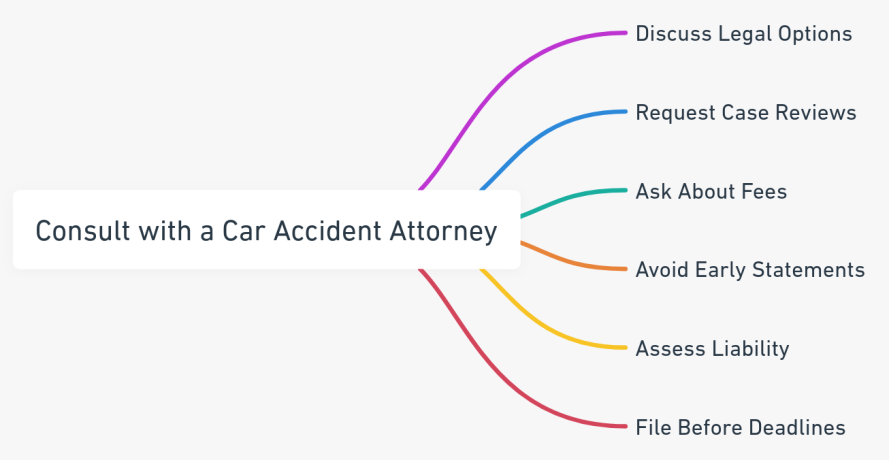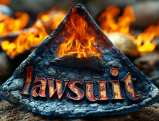
After a car crash, it's about staying safe, knowing what legal steps to take, and getting the right care for you and your car.
by LawInc Staff
November 13, 2023
Car accidents affect over 6 million people in the U.S., annually. Accordingly, knowing what to do if you’ve been involved in a vehicle collision is crucial.
To ensure your rights are protected, and that you receive fair compensation, it’s also important to immediately consult with a lawyer if you have been involved in a motor vehicle collision.
A qualified attorney can help you efficiently navigate the often complex legal system and insurance process.
Been in an Accident? Contact LawInc
LawInc can connect you directly with a car accident attorney who can help. If you need immediate legal assistance, please contact us 24/7.
The following are ten crucial steps to follow if you have been involved in a car accident:
1. Move to Safety & Secure Accident Scene

Essential steps to ensure safety and secure the accident scene after a car accident.
-
- Pull Over: If vehicles can still be driven, carefully move out of the flow of traffic onto the shoulder or a side street. Turn on hazard lights to alert other drivers.
- Prevent Further Collision: Set up road flares or warning triangles to alert oncoming traffic of hazards and obstructed roadway. Try to prevent additional accidents.
- Wait for Police: Remain at the accident scene if possible until police arrive, unless circumstances become extremely unsafe. Do not flee the scene immediately.
Max, Post Minor Rear-End Collision:
-
- Moved vehicle to shoulder, ensuring traffic flow and safety.
- Set up road flares, alerting drivers, reducing risk of further accidents.
2. Call 911 to Report Accident & Request Medical Aid

Steps for reporting an accident and requesting medical aid, crucial in the aftermath of a car accident.
-
- Call Even If No Injuries: Getting an official accident report is important even if no one seems injured. Call 911 so police and medical teams are dispatched.
- Describe Scene: Provide dispatch with specific location, number and type of vehicles involved, apparent property damage, any concerning injuries, and hazards blocking the roadway.
- Request Police Response: Police can facilitate medical assistance, take witness statements, direct traffic safely, and document details for the official crash report.
Sarah’s Prompt Action After Witnessing Collision:
-
- Called 911 despite no visible injuries.
- Gave exact location, vehicle details, reported property damage.
- Police dispatch managed traffic, created vital report for insurance.
3. Exchange Driver & Vehicle Information

Key steps for exchanging driver and vehicle information following an auto accident.
-
- Collect Details From All Parties: Get full names, driver’s license numbers, insurance details including provider and policy number, phone numbers, addresses, and vehicle registration info.
- Note License Plates: Document all vehicles involved including make, model, year, color, and license plate number.
- Limit Conversation: Only discuss critical details and facts. Do not admit fault or speculate about what happened.
Emma & Jake, Post Fender Bender:
-
- Exchanged information: Names, licenses, insurance details, contact info.
- Noted car details: Make, model, year, color, license plate.
- Focused on facts, avoided fault discussion, aiding clear, fair insurance process.
4. Document Accident Scene Thoroughly

Detailed steps for documenting an accident scene, essential for legal and insurance purposes.
-
- Take Photos From All Angles: Photograph damage to all vehicles, injuries and blood, skid marks, dents, any obstacles or conditions that contributed to the crash, and overall scene.
- Measure Skid Marks: Use a tape measure or other means to document skid mark lengths, distances, and locations as they can help reconstruct what occurred.
- Draw Detailed Diagram: Note positions of all involved vehicles both before and after the accident, traffic lights or signs, obstacles, directions vehicles were traveling, and surrounding road features.
Rachel’s Thorough Documentation Post-Accident:
-
- Photographed scene: Vehicles, injuries, road conditions.
- Measured skid marks: Crucial for event reconstruction.
- Created detailed diagram: Vehicle positions, signage, road layout.
- Documentation aided in clear, accurate insurance and legal process.
5. Obtain Eyewitness Statements & Contact Info

Steps to gather eyewitness statements and contact information, a crucial part of the post-accident process.
-
- Record Observations: Ask eyewitnesses what exactly they saw happen, heard, or observed prior to, during, and after the accident sequence.
- Compare Accounts: Note any discrepancies between witnesses’ versions of events and check for consistencies.
- Request Written Statements: Police may arrive after witnesses have left the scene. Try to get written statements documenting what they observed.
Carlos, Post Intersection Collision:
-
- Approached eyewitnesses for observations.
- Noted traffic light sequence, vehicle speeds.
- Collected contact info, requested written statements.
- Eyewitness accounts aided police investigation, clarified accident details.
6. Seek Prompt Medical Evaluation & Care

Essential steps for seeking medical evaluation and care after an auto accident.
-
- Get Checked Out Thoroughly: Even for seemingly mild discomfort or ambigous symptoms, get evaluated urgently. Soft tissue injuries and internal damage can have delayed onsets.
- Explain Pre-Existing Conditions: Disclose any pre-existing medical issues to your doctor as accident trauma can exacerbate underlying conditions.
- Follow Up with Your Doctor: Serious issues like concussions, spinal injury, PTSD may require multiple visits with your primary doctor, specialists, or other healthcare professionals.
Linda’s Post-Collision Medical Attention:
-
- Felt neck discomfort, visited ER for check-up.
- Diagnosed with mild whiplash, risk of overlook due to delay.
- Informed doctors of previous back problems for better care.
- Followed up with primary doctor, chiropractor for ongoing treatment.
- Prompt medical attention crucial for accurate diagnosis, effective treatment.
7. Consult with a Car Accident Attorney

Guidance on consulting with a car accident attorney, a critical step in navigating legal proceedings post-accident.
-
- Discuss Legal Options: An attorney can explain settlement amounts, deciding between settlement or lawsuit, and factors that determine case value such as liability, verdicts in similar cases, special damages, negotiating strategy, and time required to reach resolution.
- Request Case Reviews: Ask about the attorney’s past record on relevant cases, win/loss rates, settlements obtained, and trial experience if needed.
- Ask About Fees: Most personal injury attorneys work on contingency meaning no upfront payment. They receive a percentage of any settlement or award.
- Avoid Early Statements: Recorded statements can be used against you. Speak to an attorney first to understand how to protect yourself.
- Assess Liability: An attorney can investigate who is at fault if it is unclear. They can determine the at-fault driver’s policy limits and assets to maximize potential compensation.
- File Before Deadlines: Strict statutes of limitations apply to personal injury lawsuits. A knowledgeable attorney ensures filing within deadlines to preserve your rights to legal action.
Maria’s Legal Consultation Post Multi-Car Crash:
-
- Sought attorney’s advice on settlement, lawsuit options.
- Reviewed attorney’s past successes, discussed contingency fees.
- Avoided early statements to insurers on attorney’s advice.
- Attorney assessed liability, crucial for compensation maximization.
- Ensured claim filed within legal deadlines.
- Legal guidance key for protecting rights, optimizing claim outcome.
8. Refrain From Speculative Statements

Key advice on avoiding speculative statements post-accident.
-
- Decline Recorded Statements: Politely refuse to provide recorded statements to insurance providers without your attorney present and guiding the process.
- Stick to Facts: When describing the accident to police or others, stick to factual observations and avoid admitting guilt or speculating about the cause.
- Consult Attorney First: Before accepting any blame or liability, speak with your attorney to protect yourself from damaging admissions.
Sophia’s Caution Post Traffic Incident:
-
- Declined recorded statement to other party’s insurance, waited for attorney.
- Provided factual account to police, no speculation or guilt implication.
- Consulted attorney before discussing incident further.
- Avoiding speculation, premature admissions protected her legal position.
9. Notify Your Insurance Provider

Steps for notifying your insurance provider post-accident.
-
- Prompt Notification: Most policies require notice within 24-48 hours. Late reporting can jeopardize your claim.
- Cooperate with Investigation: But get guidance from your attorney on providing an official recorded statement or interview.
- Discuss Coverage: Ask your attorney to explain the claims process, advise on benefits entitled to, and answer any questions about your provider’s policies.
Jason’s Prompt Insurance Notification Post Collision:
-
- Notified insurance quickly, provided key details.
- Avoided formal statement without attorney’s guidance.
- Cooperated with investigation under legal counsel’s advice.
- Balanced approach safeguarded interests, aided claim navigation.
10. Maintain Records & Documents

Guidelines for maintaining records and documents post-accident.
-
- Keep Paperwork Organized: Create files organizing medical bills, receipts for medications and equipment, communication with health providers and insurers, property damage estimates and invoices.
- Catalog Injuries & Treatment: Keep a detailed journal tracking doctor visits, prescribed medications/dosages, procedures, diagnostic tests, therapy appointments, recovery restrictions, treatment timelines, and symptom changes.
- Back Up Digital Evidence: Save copies of photos, videos, audio recordings to both cloud storage and physical devices in case originals are lost/destroyed.
Elena, involved in a minor car accident, organized all related documents meticulously:
-
- Created files for medical bills, receipts, insurance correspondence.
- Maintained journal: Doctor visits, medications, treatment details, symptom tracking.
- Backed up digital evidence: Accident scene photos, audio, on cloud and physical devices.
Been in a Vehicle Accident?
If you have been injured in an auto accident, it’s essential that you immediately speak with an attorney. Being in an auto accident is extremely stressful and an experienced personal injury attorney can help protect your rights, build your claim, and work towards maximum compensation for your losses.
Contact us to learn how LawInc can help.











